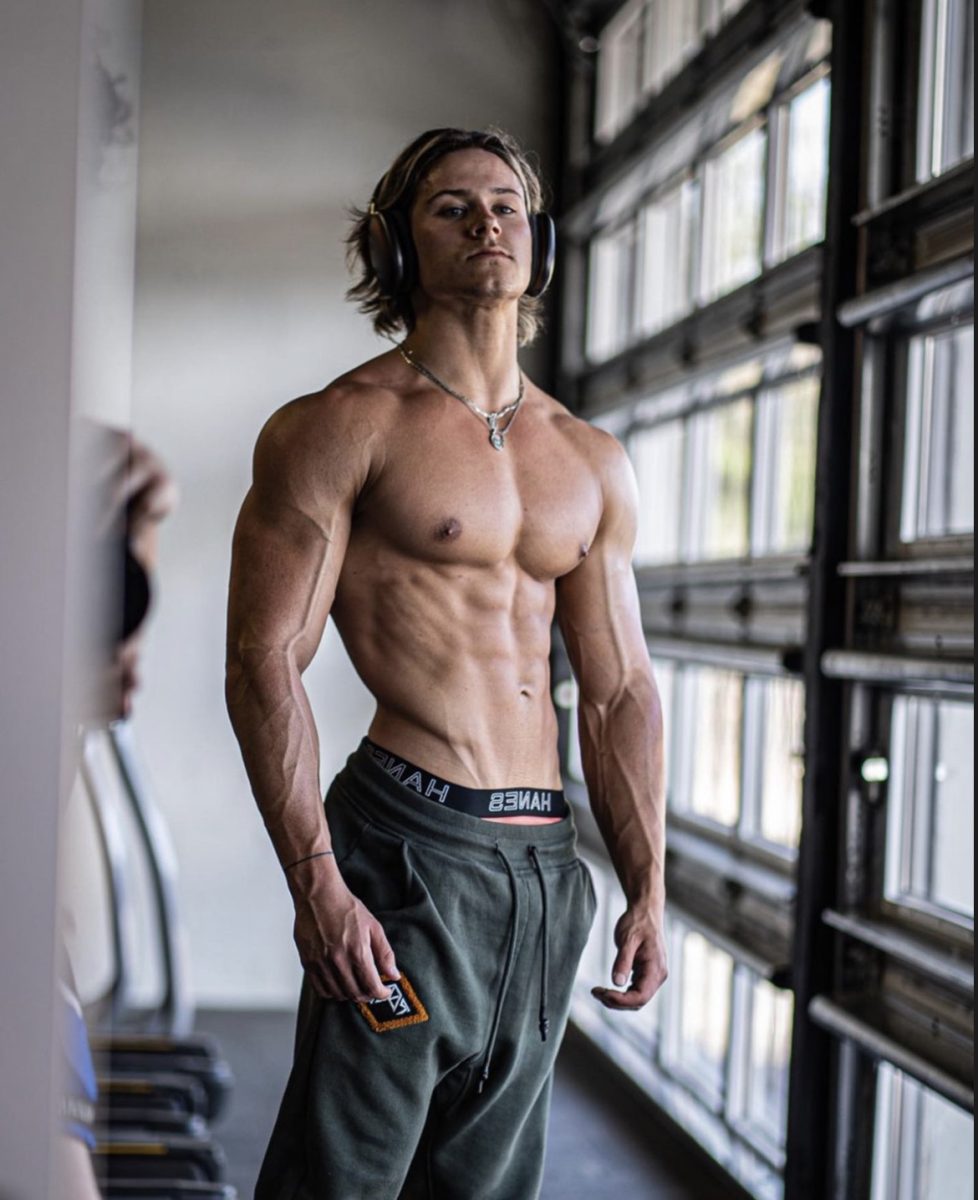
The dark side of looksmaxxing
Anyone who has spent time online in the past decade will recognize the impact that the glow up trend has had on popular culture. From 15-second TikTok videos where someone’s childhood photo transitions to a clip of them now to hour-long YouTube videos that provide a step-by-step guide to “glowing up,” people seem obsessed with finding answers to the age-old question of how to be hot.
The looksmaxxing trend seen on TikTok today is essentially a reiteration of former glow-up trends. The only difference is that looksmaxxing in particular caters to a predominantly male audience and has some not-so-subtle incel undertones. Broadly speaking, looksmaxxing is any attempt to improve one’s appearance, and these methods most commonly include things like going to the gym, getting a haircut or improving one’s style.
Looksmaxxing largely rose from the concept of lookism, which is the incel theory of objective beauty grounded in both eugenics and racism — more on that later. Looksmaxxing methods have the primary goal of turning one into the “ideal man,” equipped with big muscles, glass skin and a jawline that can cut through stone. In this spread, we will dive into the looksmaxxing rabbit hole to uncover the causes and consequences of this controversial trend.
Originally coined by a queer female student in the late ‘90s, the term “incel” rose to prominence in the 2010s on platforms like 4chan and Reddit. Incel stands for involuntary celibate, and incels tend to be men who feel that their appearance or other uncontrollable factors prevent them from attracting women. Men involved in the incel community typically express extreme resentment and hostility toward sexually active women and men, and just women in general.
Over the past decade, incels developed an extensive vocabulary, most of which is recorded on the Incel Wiki, to explain their predicament, such as the terms Chads, men who are genetically fortunate enough to participate in the dating world, and Stacys, the female equivalent to Chads.
The “pill universe,” one of the more known aspects of incel culture, shows up in many different incel online chats and groups. Different pills represent ideologies, mindsets and lives that incels choose to live. The two predominant pills, redpill and bluepill, take inspiration from the 1999 film, “The Matrix.”
Redpill describes the manosphere as a whole by representing the choice of accepting the belief that men face more oppression than women. Bluepill describes the choice of someone who prefers to ignore this belief and not change their worldview. Blackpill represents the incel ideology as a whole. By “taking” a blackpill, incels assert that physical attractiveness decides whether a man experiences romance or not. Money, social skills and social status distinguish themselves as defining features, but physical attractiveness, determined primarily by uncontrollable factors like genetics, seals the deal.
Different physical traits impact the PSL rating someone receives. PSL, which is an acronym for the PUAhate, SlutHate and Lookism online forums, is a 10-point scale used to rate someone’s physical attractiveness. A weak jaw, for example, makes a man a 2/10 while a negative canthal tilt, or downward slanted eyes, repels universally. Both characteristics, along with many more, are considered unmasculine by the incel community. They signify weakness and low SMV or “sexual market value,” the primary measure of an individual’s worth according to incels.
All of these ideas about attractiveness and individual worth are under the broader umbrella of “Lookism” — the incel theory of objective beauty grounded in both eugenics and racism. Also according to the theory, women are far more likely than men to date “out of their league” in what incels call hypergamy, meaning men who are of average or low attractiveness find little luck in dating.
The idea of hypergamy is what fuels the majority of hate and misogyny prevalent on incel forums, and according to nihilistic, blackpill incel ideology, men who are of average or low attractiveness have three options: surgery, suicide or “going ER” — a reference to Elliot Rodger, who killed six people on the UC Santa Barbara campus in an act of “retribution” against women who had rejected him.
However, not all incels are so cynical, and many promote seemingly less-harmful methods of “ascension” — the incel term for leaving the inceldom. This is where looksmaxxing comes in.
For one, looksmaxxing terminology is adopted almost exclusively from incel lingo, including the term “looksmaxxing” itself which originated on PSL forums. Also, the beauty standards of the looksmaxxing trend are almost identical to the standards of the PSL rating system, including sharp jawlines and positive canthal tilts. The main difference between incels and looksmaxxers is that instead of blaming women and society for their lack of romantic experiences like incels do, looksmaxxers aim to better themselves to get women.
Incel culture and looksmaxxing, both social cultures from the internet that influence teenage boys and young men, persist in online spaces. And even though the trends have their differences, it is important to recognize the undertones of incel culture present in the looksmaxxing trend.
Modern-day weightlifting has been around since about the 19th century, with an introduction at the Athens Olympic Games in 1896 in track and field. However, lifting wasn’t recognized as its own event until 1914.
Now, many teens are striving for the perfect build through a practice known as “gymmaxxing,” which is the practice of upgrading one’s physique and attempting to look bigger, stronger and more “aesthetic” by frequenting the gym. Through its spread on social media, many teens try to look more like popular influencers such as Sam Sulek, a bodybuilder who has been lifting for many years and openly admits he has taken steroids, or Alex Eubank, another popular bodybuilder who is shockingly lean, almost to an unhealthy point, and Eubank himself acknowledges the danger of maintaining a physique like his.
“Gymmaxxing” consists of many different aspects, one of which is ego lifting. Ego lifting is when someone lifts to their maximum capabilities too often to show off their strength, hence the “ego.” Typically, people will ego lift on the bench press, leg press or while doing bicep curls. While ego lifting can boost teens’ confidence every time they max out on a movement, it can become toxic when teens push past the point of their physical limitations and injure themselves. For example, some videos on TikTok show teens pushing too much weight on a leg press, which causes their knee to hyperextend and their ligaments, such as their ACL or PCL, to tear.
Dieting is another large aspect of the gymmaxxing trend. One of the more extreme diets is the carnivore diet, which consists of eating only animal products. Joe Rogan popularized the diet in 2020 when he ate only two meals a day of solely meat to lose weight and treat his autoimmune disorder, vitiligo. Since then, it has gone viral on TikTok, with the hashtag #carnivorediet garnering over 1.3 billion views.
While millions of people have cited weight loss and improved energy as benefits, there are many potential consequences of consuming only meat. For one, the carnivore diet increases one’s risk for heart disease. Although dietary fat has received much unfair criticism throughout the years, eating saturated fat raises LDL (“bad” cholesterol) in all people, and many studies have found that unhealthy levels of LDL are linked to heart disease.
New lifters focus too much on the supplements. They really expect them to boost their growth when in reality, they just need to stay dedicated and have a schedule and do the research.
— Deshawn Huggar, '25
Supplements are a touchy subject in the gym community. “Gymmaxxing” influencers can sometimes encourage others to consume extreme amounts of creatine, pre-workout, protein powder and sometimes even steroids. “New lifters focus too much on the supplements. They really expect them to boost their growth when in reality, they just need to stay dedicated and have a schedule and do the research,” said junior Deshawn Huggar.
Steroids are the most sensitive subject when it comes to “gymmaxxing” because they can be harmful when taken without a physician’s direction. Some common steroids are trenbolone acetate, known as tren, and testosterone, known as TRT or test. Some gym-goers are incentivized to take steroids because it takes a significant amount of effort to develop and maintain a quality physique naturally. However, the misuse of steroids can have devastating side effects, including cardiovascular complications, liver disease and reproductive organ damage, according to the Better Health Channel.
Lifting can be a healthy practice for teens when performed safely and with the correct technique, but once teens begin overtraining, starving to lose a couple of pounds, overdoing supplements and looking to the media for what they should look like, it becomes dangerous.
On Oct. 2, 2022, popular gaming YouTuber Dream revealed his face to the world. Because Dream hid his identity through a mask for years, many people who idolized him crafted an image in their minds of what they thought he looked like or what they wanted him to look like. After Dream finally posted a video revealing his face, he received heavy backlash, with thousands of people on social media mocking him for his appearance. These comments included memes comparing his face to cartoon characters, such as Lord Farquaad. While some comments carried a lighthearted tone, the atmosphere swiftly transformed into people mocking his jawline and other facial features, leading to the trending hashtag #PutTheMaskBackOn on X, formerly Twitter, in response to the reveal.
-
[infographic credit="" align="center"]
THEY MADE DREAM HIS OWN EMOJI??? 🌜🌜🌜#dreamfacereveal #PutTheMaskBackOn
— Jakey (@Jakey_twi) October 5, 2022
[/infographic]
-
[infographic credit="" align="center"]
#PutTheMaskBackOn
lol me to dream— LOREN !! 🗯 (@CRYBABYTSUKASA) October 31, 2022
[/infographic]
-
[infographic credit="" align="center"]
#PutTheMaskBackOn #HESUGLY go away dream
— Harry (@Harry2339_) October 26, 2022
[/infographic]
Beauty standards on social media or other digital platforms often influence the desire for facial enhancement. For instance, platforms like TikTok showcase short, highly edited videos where users often employ filters and editing techniques that accentuate facial appearance and alter overall appearance. This exposure fuels a desire for perfect facial features, leading to more comparison and a distorted image of beauty. This surge in glow-up culture on social media has played a pivotal role in giving rise to trends like looksmaxxing.
The desire for an individual to enhance their facial appearance forms a crucial component of looksmaxxing. Individuals engage in various practices, from basic facial grooming to advanced procedures to achieve the “ideal” facial aesthetic.
A few years ago, when I saw a guy, their skincare routine was kind of just like a 13-in-one shampoo, moisturizer and all that, and now I feel like guys and everyone I know have skincare routines.
— Olmasaan Ebisso, '25
Looksmaxxing branches into two categories: softmaxxing and hardmaxxing. Softmaxxing adopts a gradual, holistic approach to self-improvement through practices such as daily skincare routines and consistent exercise. “A few years ago, when I saw a guy, their skincare routine was kind of just like a 13-in-one shampoo, moisturizer and all that, and now I feel like guys and everyone I know have skincare routines,” said junior Olmasaan Ebisso.
One viral technique heavily associated with softmaxxing, mewing, involves tongue posture adjustment to enhance one’s jawline. However, limited scientific evidence supports its effectiveness, and recent widespread adoption has led to a rise in other facial reconstruction methods.
Conversely, hardmaxxing involves more invasive and risky methods, including plastic surgery and extreme workout regimes. These methods focus on specific aesthetic goals with a willingness to undergo significant procedures for rapid results.
Among hardmaxxing trends, bonemashing stands out as a practice where individuals use blunt objects such as hammers or massagers on their faces to fracture their bones in hopes that the bones will heal back stronger, leading to a more defined jawline and overall facial structure. However, few people have actually attempted this trend, as it emerged from people trolling on incel forums. Orthopedic surgeons also warn that bonesmashing has severe health risks, such as infections and permanent damage to facial tissues.
Similar to incels, many looksmaxxers praise specific jaw structures or eye shapes unattainable through natural methods. One such feature is a positive canthal tilt, where the outer corner of the eye sits higher than the inner corner. This results in more expressive and piercing eyes, known as hunter eyes by the looksmaxxing community.
Because people cannot achieve these features naturally, cosmetic surgery represents a more drastic approach to looksmaxxing. Procedures such as rhinoplasty or jawline enhancements aim to alter facial appearance quickly and permanently. While these surgeries can address certain aesthetic concerns and improve self-confidence, they also carry risks, including nerve damage, infections and scarring, that individuals should carefully consider. “I think for the most part, people should be happy with how they look, and I don’t think people need [plastic surgery],” said senior Parker Bryntesen.
Prolonged exposure to idealized facial images online, especially to messages praising unchangeable features of a person, can contribute to issues such as body image struggles and distorted self-perceptions. The pursuit of facial perfection through looksmaxxing can lead to heightened self-criticism, where perceived flaws, even minor ones, become magnified.
Looking ahead, uncertainty looms over whether looksmaxxing as a social media trend will fade, but it seems likely that people will continue to strive for perfect appearances for years to come. “South Korea, for example, they have a lot of plastic surgery and stuff like that. We might be heading in that direction; I’m not really sure,” said Bryntesen. “But we’re also heading towards more self-acceptance with how you look, so it’s hard to say.”
-
 SpreadThe rising trend of overconsumption
SpreadThe rising trend of overconsumption -
 Spread[COLLECTION] The rise of sports betting
Spread[COLLECTION] The rise of sports betting -
 SpreadThe downfall of ELA education
SpreadThe downfall of ELA education -
 SpreadA deep dive into the new generation of conspiracy theories
SpreadA deep dive into the new generation of conspiracy theories -
 SpreadThe caffeine craze
SpreadThe caffeine craze -
 SpreadThe teacher shortage crisis
SpreadThe teacher shortage crisis -
 SpreadOur community's car dependency
SpreadOur community's car dependency -
 SpreadSocial Structure
SpreadSocial Structure -
 SpreadDifferent paths after high school
SpreadDifferent paths after high school -
 SpreadA history of Mounds View
SpreadA history of Mounds View














